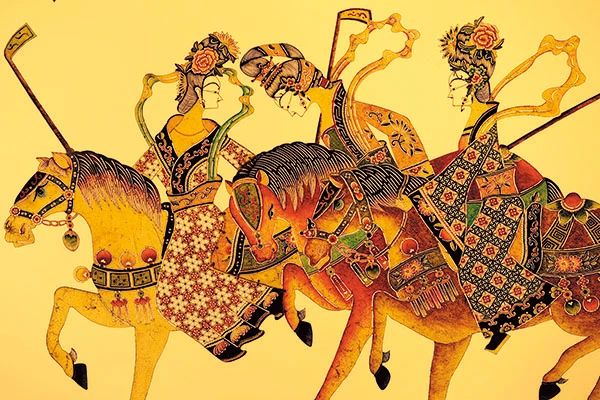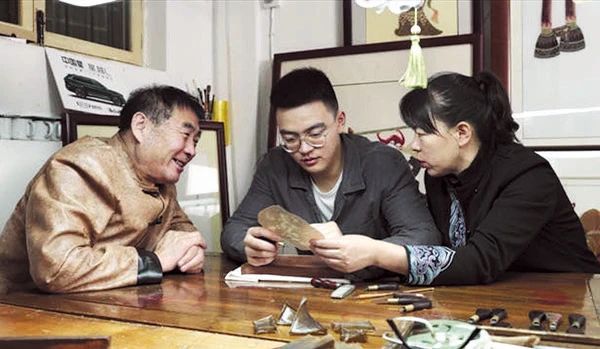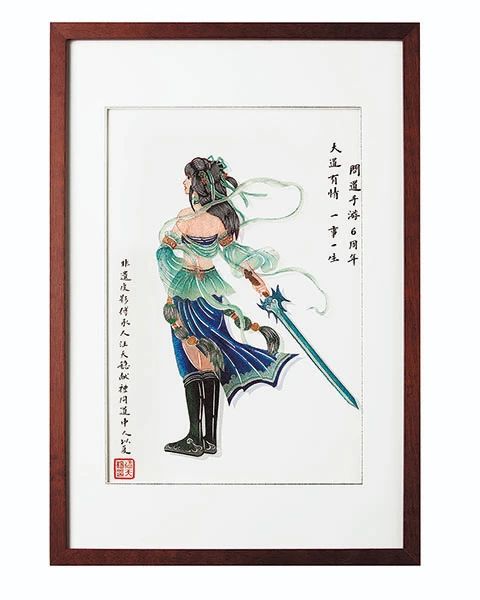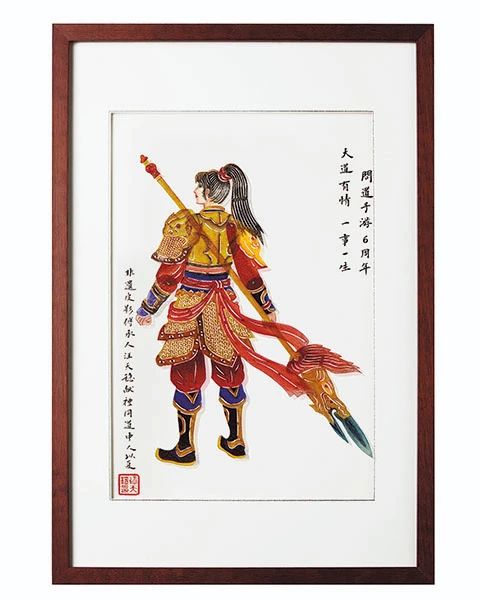Life丨The heritage hidden in shadows
Young inheritor of Shaanxi puppetry has plans to revitalize the ancient cultural tradition, and many others with it, Li Yingxue reports.

▲A shadow puppetry artwork created by Wang's Shadow is exhibited during the China-Central Asia Summit in Xi'an in May. [Photo provided to China Daily]
Have you ever experienced one of the earliest precursors of movies? It boasts star-studded ensembles, undergoes rapid transformations in the blink of an eye, and even includes special effects, music and performances, all without the aid of machines or computers.
Solely relying on hands, the ancient Chinese art of shadow play is a tradition with a history that dates back 2,000 years, and it's also a representative of the Intangible Cultural Heritage of Humanity recognized by UNESCO.
Last month, two prominent online personalities, each with more than 10 million followers, Nanxiang Buaichifan and Jiuyue, shared videos documenting their journey to learn how to perform shadow puppetry that have garnered over 20 million views on social media platforms, such as Bilibili and Douyin.
"Some romance may have long faded, but we can use traditional techniques passed down through the generations to create a romance that belongs to today's world, which is marked by hardships and complexities," Bilibili content creator Shujiangyuan wrote, commenting on Jiuyue's video.
The two personalities dedicated a month to learning the art from scratch, beginning with the intricacies of handling cowhide, before progressing to drawing and carving, culminating in a joint performance with the shadow puppets they had made.

▲Dang Feihua is the fifth-generation inheritor of Wang's Shadow, a family troupe based in Xi'an, Shaanxi province, which is famous for shadow puppet making and especially its carving skills. [Photo provided to China Daily]
The challenge of mastering this millennia-old technique within such a short time frame initially seemed like mission impossible. Fortunately, Nanxiang Buaichifan and Jiuyue were lucky enough to learn from the best — Dang Feihua, a 23-year-old inheritor of the shadow puppetry tradition.
Dang is the fifth-generation inheritor of Wang's Shadow, a family troupe based in Xi'an, Shaanxi province, which is famous for shadow puppet making, and especially its carving skills. Dang's mother Wang Haiyan is one of the top 10 folk artists in China, and his grandfather Wang Tianwen is an industrial art master. Dang has embraced the family legacy. Not only does he skillfully blend the traditional with the contemporary in his creations, he also pioneers methods to enhance the presentation and preservation of this cultural heritage, especially ways of integrating the ancient art form into daily life.
Collaborating with the two prominent online personalities was a strategic move to introduce the world of shadow puppetry to the influencers' young followers.
Dang says that the duo took their apprenticeships seriously. "Jiuyue has a foundation in painting, so she learned quickly, while Nanxiang Buaichifan, having experimented with various crafts, also caught on swiftly. Both of them approached their training with great seriousness," he says.

▲Dang (center) with his grandfather Wang Tianwen (left) and his mother Wang Haiyan. [Photo provided to China Daily]
Nanxiang Buaichifan says that Dang and the other teachers he worked with generously imparted their knowledge in the hope that the younger generation finds ways to convey the essence of shadow puppetry in a manner that resonates with today's youth.
"In an age without smartphones, traditional performances were what kept our country entertained for thousands of years. Without elaborate props or teams of actors, a single performer is able to evoke the grandeur of armies, traversing the millennia," he says.
Jiuyue says: "The small shadow puppet transcends artistry; it embodies a fragment of history, a slice of culture, and a chapter in the annals of folk art."
As Dang explains, Chinese shadow puppetry has its roots in the Han Dynasty (206 BC-AD 220), and the Shaanxi tradition has been associated with royal artistry since its inception, and is known for its exquisite craftsmanship.
"It gradually transitioned from royal to folk art, spreading outward with Shaanxi at its core. You can even trace its presence along the Silk Road," says Dang, who was born and raised in Xi'an.
From watching his grandfather and mother make shadow puppets since childhood, Dang gradually acquired the skill himself. "It's like standing beside a chef, smelling the aromas and intuitively knowing what ingredients to add to the pot," Dang says.

▲A collaborative shadow puppetry work by Wang's Shadow in partnership with a mobile game. [Photo provided to China Daily]
The core technique of Wang's Shadow lies in the art of pushing the leather while the tip of the knife remains stationary. With the application of force from just a few fingers, tough bull hide is maneuvered against the knife's edge, resulting in lines that are not only sharp and clean, but also intricate and delicate.
When it comes to the crucial wrist and forearm strength needed, Dang chose a different path to his elders. Rather than employ the traditional method of hanging weights on the wrist, he opted for a modern approach — hitting the gym and lifting dumbbells. "The younger generation today connects with fundamentals in different ways," he says.
In 2019, Dang enrolled at Northwest University in Xi'an to major in biology. "I enjoy studying biology, including researching interesting mountain animals like golden monkeys," he says.
Due to the pandemic, he took most of his classes online, which gave him more time to take over the family business, and he has postponed graduation for a year to give more attention to promoting shadow puppet culture.
During the China-Central Asia Summit in Xi'an in May, Dang and his team designed a 10-meter hallway with shadow puppets for the attendees.
"We used the puppets to illustrate female heroes from films, along with many colorful scenes and maps depicting countries involved in the Belt and Road Initiative," Dang says.
Traditional Wang's Shadow puppets are mostly destined for collection. However, Dang thinks that this should not be the only choice.
His team has around 10 craftsmen, mostly middle-aged, who have studied with his mother and grandfather for many years. This year, with his family's support, Dang is expanding the team and wants to be involved in more cultural and innovative projects.
"We need to seamlessly integrate shadow play into our lives, to make it attractive to the younger generation, so that this cultural tradition thrives, rather than remain confined to lifeless museum exhibits," he adds.
He envisions incorporating shadow puppet elements into various aspects of daily life, including clothing, food, housing and transportation, through more interdisciplinary collaborations.
"We aim to demonstrate the excellence of our traditional culture, and its ability to produce remarkable creations. Once people realize that shadow puppets can be cool, their natural inclination will be to become involved," he says.

▲A collaborative shadow puppetry work by Wang's Shadow in partnership with a mobile game. [Photo provided to China Daily]
Besides exhibitions and performances at home and abroad, Wang's Shadow has tried many other ways to present and promote shadow puppetry, including crossover cooperation with artists and directors, and launching cultural, innovative and customized products with brands.
One of Dang's plans is to redecorate their shadow puppet themed hotel in Beijing at the end of the year. It reopened in July after the pandemic and is usually fully booked. "We have shows on Tuesdays, Thursdays and Saturdays, and we also teach our guests to make puppets," he says. "It used to be more of a traditional hotel, but we are integrating traditional culture into the modern lifestyle."
He says that the hotel will turn its public space into a museum of shadow puppetry, exhibiting many of his family's shadow puppets that haven't had an opportunity to be presented.
Innovation and inheritance are happening simultaneously, and for the last four years Dang has been collecting information and material about shadow puppetry.
"I used the taxonomy I learned at college to collect the materials and separate them into different categories like performance and manufacturing skills," he says.
He also collects sketches of shadow puppet figures and scripts, some of which date back to the Qing Dynasty (1644-1911).
Dang spends an hour or two each day with his mother and grandfather asking them about shadow puppetry and taking notes, and has noticed that the clothes the old shadow puppets wear are records of the time they were made.
"We record this information as practitioners in the field. In the future, I want to collaborate with research institutions so that they can collect materials in a more professional way, and help them systematically archive the history of Chinese shadow puppetry," Dang says.
His aspiration is to go beyond simply promoting shadow puppetry. He also wants to find more effective ways of promoting all of China's intangible cultural heritage.
"There's a plant called Arabidopsis thaliana, which is internationally recognized as a model organism in plant research, a kind of lab rat for plant scientists. For intangible cultural heritage, shadow puppetry serves as an excellent model; it is like the Arabidopsis thaliana of intangible heritage.
"I channel all my ideas for revitalizing traditional intangible cultural heritage into shadow puppetry. Following the success of shadow puppetry, we can share this model with other relevant educators, to revitalize more aspects of our heritage," he says.
Reporter: Li Yingxue
